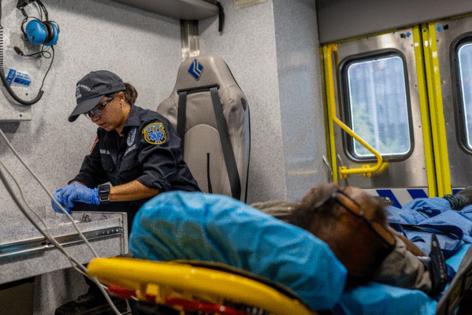Historically redlined communities have slower EMS response times
Published in News & Features
Residents of historically redlined communities experience slower response times from emergency medical services, according to a study published Tuesday in JAMA Network Open.
Redlining refers to the discriminatory practice under which the federal government and banks systematically denied mortgages to Black and Hispanic residents. The practice deemed neighborhoods with higher proportions of nonwhite residents to be undesirable and financially risky for mortgage lending.
Researchers mapped locations of EMS centers across 236 cities and analyzed maps produced in the 1930s by the Home Owners’ Loan Corporation. The government agency, created as part of the New Deal, consistently ranked majority-Black areas as “hazardous” for lending. Redlining has been illegal since enactment of the federal Fair Housing Act in 1968.
The research team calculated average EMS response times using the location of ambulance, fire and rescue services and historical traffic data. “Rapid” response was defined as five minutes or less, the benchmark set by the National Fire Protection Association for high-priority patients with life-threatening conditions.
The team found that more than 2.2 million people lack rapid EMS access. Areas historically graded “D” — financially “hazardous” for mortgage lending — had a significantly higher proportion of residents (roughly 7%) without rapid EMS access, compared with about 4% of residents in historically “most desirable” A-graded neighborhoods. D-graded neighborhoods had higher proportions of Black residents, whereas A-graded neighborhoods had more white residents.
Disparities were particularly acute in the Great Lakes region, the authors note. The odds of lacking rapid access to EMS were nearly three times higher for residents in historically D-graded neighborhoods, compared with A-graded neighborhoods in that region.
The findings add to the evidence linking policies rooted in structural racism to health disparities.
Research has shown redlined neighborhoods still disproportionately grapple with a multitude of health disparities, lower life expectancy and more exposure to air pollution.
The study found a racial disparity in where EMS stations are located, with fewer EMS stations in urban communities of color. Better tracking and accountability of EMS response times in communities could help address the issue, the researchers wrote.
Delays in emergency care are associated with higher mortality rates. For traumatic injuries, timely care is critical during what EMS professionals call the “ golden hour,” or the first 60 minutes after an injury.
Other research has pointed to disparities in emergency response times. EMS response times for patients with cardiac arrest, for example, were 10% longer for low-income ZIP codes than high-income ZIP codes, according to a national study published in JAMA Network Open in 2018.
The study received funding support from the National Institutes of Health’s National Institute of Minority Health and Health Disparities.
____
Stateline reporter Nada Hassanein can be reached at nhassanein@stateline.org.
____
©2025 States Newsroom. Visit at stateline.org. Distributed by Tribune Content Agency, LLC.







Comments